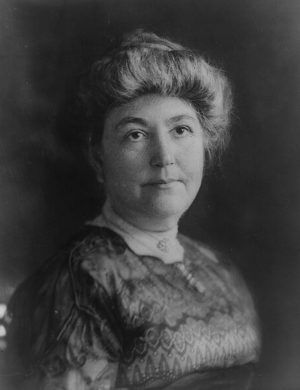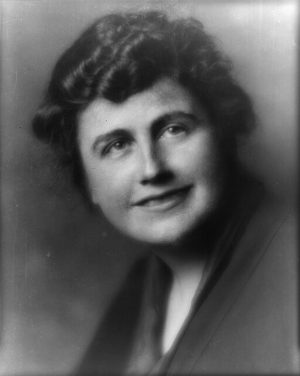Woodrow Wilson was the 28th President of the United States. He served from 1913 to 1921. He was a very intelligent man and also quite creative. He is most well-known for his role in World War I and his progressive policies as president. His family life, however, was not always happy. Wilson’s first wife, Ellen Louise Wilson, died from Bright’s disease on August 6, 1914. This was just two years into his first term as president. Her death devastated Wilson and their children. Eventually, he recovered and, a year later, started courting Edith Bolling Galt. In this article, we will take a look at the wives of Woodrow Wilson and how they impacted his life and presidency.
Ellen Louise Wilson (formerly Axson)
Wilson married Ellen Louise Axson on June 24, 1885. Ellen was the daughter of a Presbyterian minister, Samuel Edward Axson, and his wife, Margaret Jane Hoyt. She was born in Savannah, Georgia, and raised in Rome, Georgia. At only 11 years old, she began studying art at the Rome Female College.
Marrying Woodrow Wilson
She met Woodrow Wilson in April 1883, when he visited Jesse Woodrow Wilson, his cousin, in Rome. They met in church, and Woodrow was immediately smitten. They were engaged after five months and married on June 24, 1885. That same year, Wilson was offered a teaching position at Bryn Mawr College, so the couple moved to Pennsylvania and lived near the campus. The couple had three daughters: Margaret Woodrow Wilson (1886-1944), Jessie Woodrow Wilson (1887-1933), who married Harvard Law School professor Francis B. Sayre, and Eleanor Randolph Wilson (1889-1967), who married lawyer and politician William Gibbs McAdoo.
Role as First Lady
Ellen was a supportive wife and an excellent hostess. Though Wilson’s administration was the first not to hold an inaugural ball when he was elected president in 1912, Ellen’s cordiality made future White House parties successful. She also oversaw the weddings of their two daughters. She continued doing art while living in the White House and even had a studio set up on the third floor. She donated many of her paintings to charity. As First Lady, Ellen Wilson worked tirelessly to improve housing in Washington’s poverty-ridden and largely black slums.
Death
However, she also suffered from Bright’s disease, a kidney ailment, which made her increasingly frail. Despite this, she continued to support her husband’s work. On August 6, 1914, just two years into Wilson’s first term as president, Ellen Wilson died from Bright’s disease at 54. Wilson was devastated by her death. With his wife’s death and the stress that came with being president, Wilson was left feeling lonely and downhearted. A year later, he met Edith Bolling Galt in the elevator at the White House. They got married at Edith’s Washington townhouse nine months later.
Edith Bolling Wilson (formerly Galt)
Edith Bolling Galt Wilson was the second wife of President Woodrow Wilson and First Lady of the United States from 1915 until 1921. She was born in Wytheville, Virginia, on October 15, 1872, to Judge William Holcombe Bolling and his wife, Sarah White.
Family Background
Edith’s father was a descendant of Matoaka (better known as Pocahontas), the daughter of the paramount chief of the Powhatan Confederacy, Wahunsenacawh. Matoaka married John Rolfe, the first English settler in Virginia to cultivate tobacco as an export commodity. William Bolling was a wealthy man, but after the American Civil War, the family could not pay taxes on their properties. They were forced to give up their plantation seat and fell on hard times. William became a circuit court judge to support the family. They were not broke, but they were not as wealthy as they once were.
The Bolling household was large. Edith was born after the civil war as the seventh of eleven children, two of whom died in infancy. The older women in Edith’s family lost husbands during the war, so her grandmothers, aunts, and cousins also lived with them. In her early childhood, Edith was taught that she was superior to others because of her family’s social position. The Bolling family justified owning slaves by claiming that the slaves they owned did not desire freedom and were content with their position in society.
Education
Edith Bolling was educated at home by her paternal grandmother, Anne Wiggington Bolling. Her grandmother taught her how to read and write, how to calculate, how to speak a hybrid language of French and English, and even how to make dresses. Since her grandmother had a spinal cord injury and was confined to bed, Edith was the one who washed her clothing and looked after her 26 birds.
When she turned 15, her father enrolled her at Martha Washington College, a finishing school for young women in Abingdon, Virginia. However, Edith was miserable there and left after only one semester. She transferred to Powell’s School for Girls in Richmond, but unfortunately, the headmaster got into an accident, and the school closed after two years. William decided to stop paying for any extra schooling for Edith and concentrated on the education of her three brothers instead.
Marrying Norman Galt
A few years later, she met Norman Galt, a jeweler, and businessman, in Washington, D.C. On April 30, 1896, they got married at Saint John’s Episcopal Church in Wytheville—Edith’s hometown—but lived in Washington for the next twelve years. She gave birth to a son on September 23, 1903, but the baby died after three days, and she was unable to have any more children. Almost five years after that, her husband died suddenly at the age of 43. The business, Galt & Bro. Jewelers and their debts were left with Edith. She hired Henry Bergheimer to help her manage the shop, and she lived modestly until the debts were all paid off. In 1943, she sold the business to the shop’s employees and used the money to travel Europe.
Meeting President Woodrow Wilson
In March 1915, Edith Bolling Galt met then-President Woodrow Wilson in the White House. The president had lost his wife, Ellen Louise Axson Wilson, to Bright’s disease and was in need of someone to be the official White House hostess. His cousin, Helen Woodrow Bones, had been filling in for Ellen. Edith’s close friendship with Bones eventually led her to meet the president. They were introduced in early March and started corresponding frequently.
By May, he had proposed marriage to her. At first, she was shocked and hesitant, but she eventually accepted his proposal on May 5. However, Edith asked him to wait until the official year of mourning for Ellen ended before they got married. Wilson agreed. He was planning to run as president in the next term, and his advisors feared that if he remarried too soon, the public would see him as being disrespectful to his late wife’s memory. They were married on December 18, 1915, at Edith’s townhouse in Washington. It was a small wedding, with only 40 guests as well as Wilson’s pastor (Rev. Dr. James Taylor) and Edith’s pastor (Rev. Dr. Herbert Smith).
Role as First Lady
Before Wilson and Edith even got married, he had already entrusted her with confidential information. When he would read important documents, he would ask her to sit by him. Edith was even present during some of his meetings with advisers, although she showed little interest in politics that did not directly concern her husband. When Wilson was re-elected in 1916, Edith rarely left his presence.
World War I started not long after President Wilson was sworn in for his second term, and she worked with him, reading classified documents and sitting in on strategy meetings. She would often advise him of certain political figures and foreign representatives that she thought he should ally with or be wary of. The president allowed her to screen his mail and had the power to deny advisors access to him if Wilson couldn’t be disturbed. She also volunteered at a Red Cross canteen and convinced American women to save food so that the troops would have enough to eat. She even traveled with him to Europe when the Allied Powers discussed terms of peace.
After the Paris Peace Conference, they returned to the United States. Woodrow Wilson started campaigning for Senate approval of the Treaty of Versailles as well as the League of Nations Covenant. However, he suffered a stroke in October 1919, which left him partially paralyzed. Those in the president’s inner circle, including his physicians, decided to conceal the true extent of his illness and disability from the American public. They did not want people to think that he was unable to perform his duties as president.
Edith Wilson took on some of the duties of the presidency, including reading his mail, screening visitors, and handling routine matters. She was the one and only link the Cabinet had with the president. She decided which matters were important enough to bring to the president’s attention. She was criticized for the amount of power she had over the president, and some even accused her of being a secret dictator. However, in her memoir that was published in 1939, she claimed that she never made any important decision without consulting her husband.
Later Years and Death
President Wilson’s term ended on March 4, 1921, and he retired to their home on S Street NW, Washington, D.C. He suffered from a number of health problems, and she nursed him until his death on February 3, 1924. After Wilson’s death, Edith headed the Woman’s National Democratic Club’s board of governors.
Edith Wilson continued to live in Washington, D.C., even after her husband’s death. She was a guest of honor at President John F. Kennedy’s inauguration in 1961. She died of congestive heart failure on December 28, 1961, at the age of 89. Coincidentally, the dedication ceremony for the Woodrow Wilson Bridge just so happened to take place that day, and she would have been the guest of honor. She was buried next to her husband at the Washington National Cathedral.

